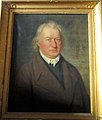Johann Kaspar Schneider
Johann Kaspar Schneider (born April 19, 1753 in Mainz , † February 24, 1839 in Mainz) was a German landscape and portrait painter .
Life
Johann Kaspar Schneider was the son of Simon Schneider, a stable servant of the Electoral Life Guard in Mainz, and his wife Agnes. He received his artistic training at the electoral court of the art-loving Friedrich Karl Joseph von Erthal under the guidance of Heidlof. He created numerous landscape pictures in which he depicted the immediate vicinity of Mainz, in particular the river and floodplain landscapes around the Rhine and Main, in naturalistic colors. With his oil and watercolor paintings, he gained recognition from both princely circles and the up-and-coming citizenry.
Schneider spent most of his creative period in Mainz, where he initially succeeded at the electoral court. In 1779 Schneider started his own business as a portrait painter. When Schneider painted a portrait of Countess Sophia von Coudenhoven in 1784, he had finally arrived in higher circles. The first landscape painting that can definitely be attributed to him dates back to 1785. Schneider chose new subjects for his works with moonshine landscapes (from 1787) and ideal landscapes (from 1790) . At the instigation of the court, he accepted the offer to travel to Italy , but did not get beyond Switzerland .
When French revolutionary troops occupied his hometown in 1792, Schneider fled Mainz and went to Düsseldorf . In 1793, when Mainz was bombarded by coalition troops from Prussia and Austria , he fled to Mannheim . When the French troops advanced on this city too, he fled to Erfurt . Schneider's portrait of Elector Friedrich Karl Joseph von Erthal was created there. After the reconquest of Mainz by the imperial troops , he finally settled in Mainz again in July 1797. Schneider received many commissions as a landscape and portrait painter and regularly took part in art exhibitions. Despite his growing popularity, he led a rather withdrawn and modest life.
The artist retained his favor with the Mainz circles when the Austrian troops left Mainz and, from 1798, “Mayence” became French for the fourth time. The cultivation of art threatened to be pushed into the background by the influence of the French Revolution. Nevertheless, Schneider turned down a position offered to him as a gallery director in Aschaffenburg in 1802 and stayed in Mainz. The members of the French imperial family became aware of Johann Kaspar Schneider during their stays in “Mayence” and gave him assignments. In 1811 Schneider was granted citizenship in Mainz.
When Johann Wolfgang von Goethe traveled to the Rhine and Maing areas in 1814, he visited Mainz and praised the artist. From 1815 Johann Kaspar Schneider painted several views of Mainz in gouache and oil . His last dated landscape paintings were created between 1830 and 1835. Other artists, such as his brother Georg and Wilhelm Lindenschmit , as well as the art patron Franz von Kesselstatt , were influenced by his life's work. On February 24, 1839, Johann Kaspar Schneider died at his main residence in Mainz.
Works (selection)
literature
- Karl Georg Bockenheimer : Schneider, Johann Kaspar . In: Allgemeine Deutsche Biographie (ADB). Volume 32, Duncker & Humblot, Leipzig 1891, p. 127 f.
- Elsa Neugarten: Johann Caspar Schneider: a Mainz painter. Catalog raisonné ed. by Paul Ferdinand Schmidt, director of the Dresden City Collections , with a foreword by Rudolf Kautzsch , Mainz, Euler, 1922, [1]
- Exhibition catalog Landesmuseum Mainz 1993
- Marlene Landschulz and others: Arcadia on the Middle Rhine. Caspar and Georg Schneider . Exhibition catalog Landesmuseum Mainz. Dr. Ludwig Reichert Verlag Wiesbaden 1998. ISBN 3-89500-069-8
Web links
- Biography Caspar Schneider
Individual evidence
- ^ Norbert Suhr: "Lindenschmit, Wilhelm", in: Neue Deutsche Biographie 14 (1985), p. 599
| personal data | |
|---|---|
| SURNAME | Schneider, Johann Kaspar |
| ALTERNATIVE NAMES | Schneider, Johann Caspar |
| BRIEF DESCRIPTION | German landscape and portrait painter |
| DATE OF BIRTH | April 19, 1753 |
| PLACE OF BIRTH | Mainz |
| DATE OF DEATH | February 24, 1839 |
| Place of death | Mainz |



